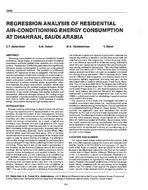Description
The energy consumption of a house air conditioner located at Dhahran, Saudi Arabia, is modelled as a function of weather parameters and total (global) solar radiation on a horizontal surface. The selection of effective parameters that significantly influence energy consumption is carried out using general stepping regression methods. The problem of collinearity between the regressors is also investigated. The final model involves parameters of total solar radiation on a horizontal surface, wind speed, and temperature difference between the indoor and outdoor condition. However, the model coefficients are functions of relative humidity and/or temperature difference between the indoor and outdoor condition. Model adequacy is examined by the residual analysis technique. Model validation is carried out by the data-splitting technique. The sensitivity of the model indicates that relative humidity and temperature difference strongly influence the cooling energy consumption. It was found that an increase in relative humidity from 20% to 100% can cause a 100% increase in cooling energy consumption during the high cooling season.
KEYWORDS: domestic, air conditioning, energy consumption, deserts, Saudi Arabia, housing, weather, total solar radiation, cooling load, calculating, wind speed, temperature difference, room temperature, outdoor temperature, relative humidity, cooling season.
Citation: ASHRAE Transactions, vol. 96, pt. 2, St. Louis 1990
Product Details
- Published:
- 1990
- Number of Pages:
- 10
- File Size:
- 1 file , 1.2 MB
- Product Code(s):
- D-18653




